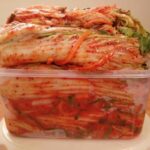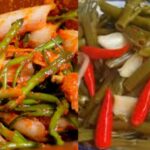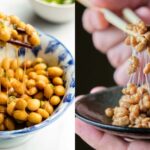Before diving into the how-to, let’s explore what kimchi is.
– What is Kimchi?
Kimchi is a spicy fermented vegetable dish from Korea, typically made with napa cabbage and radish. It boasts a unique sauce made from a blend of chili powder, garlic, ginger, red pepper, sugar, and the distinctive aroma of fish sauce. While you may be familiar with the most popular version, there are actually over 100 varieties of this classic dish, including radish, cucumber, and other types of vegetables.

– When did Kimchi originate?
According to records, kimchi dates back to the Three Kingdoms of Korea (37 BC – 7 AD). However, kimchi did not acquire its characteristic red color until around the 16th century.
– What does Kimchi mean in Korea?
Kimchi is a way of life in Korea—the numbers prove it. Approximately 1.5 billion tons of kimchi are consumed annually in this Asian country. Kimchi recipes are passed down through generations, and most Korean households have a dedicated temperature-controlled refrigerator for their kimchi. It is not only eaten on its own but is also found in countless Korean dishes, including kimchi buchimgae (scallion pancakes), ramen, kimbap (seaweed rice rolls), braised mackerel, steamed buns, and fried rice.
Every November, the entire nation begins the pickling season, preparing salted vegetables for the kimchi fermentation process. This tradition has earned them a spot on UNESCO’s Intangible Cultural Heritage List, and it is celebrated with numerous festivals, such as the Seoul Kimchi Making and Sharing Festival.

Popular Types of Kimchi
In Korean, “kimchi” means pickled vegetables, specifically fermented (not pickled in vinegar). Similar to Vietnamese dua mon or Japanese tsukemono, kimchi can be made from various vegetables such as cabbage, choy sum, daikon radish, cucumber, pumpkin, scallions, garlic chives, mustard greens, dandelion greens, pear, apple, and more. It’s safe to say that Koreans can make kimchi out of almost any vegetable.
Let’s explore some of the most popular types of kimchi.
Baechu-kimchi (Napa Cabbage Kimchi)
The recipe provided in this article is for this type of kimchi. Baechu-kimchi is also the most popular variety in Korea, Vietnam, and worldwide.
Its most prominent feature is the use of napa cabbage seasoned with a specially blended sauce, characterized by its red color from chili powder and the aroma of fermented shrimp and various vegetables.
As mentioned earlier, Baechu-kimchi can be eaten as a side dish or used as an ingredient in many other dishes.

Baechu-geotjeori (Fresh Napa Cabbage Kimchi)
This type of kimchi is called “fresh” because it is unfermented Baechu-kimchi. At this stage, the kimchi hasn’t developed its characteristic sour taste yet; instead, it has a mildly salty and sweet flavor, with the aroma of the seasoning and the fresh, juicy crunch of the cabbage.
After mixing the Baechu-kimchi, simply sprinkle some roasted sesame seeds on top, and it’s ready to be enjoyed as a salad, paired with rice or grilled meat, or added to Korean-style stews.
Bossam-kimchi (Wrapped Kimchi)
Also known as Bo-kimchi, “Bossam” means “wrapped.” This type of kimchi originates from Gaeseong in Gyeonggi Province, bordering North Korea.
Within the layers of cabbage leaves, Bossam-kimchi includes precious seafood (octopus, oyster, abalone, etc.), various nuts and medicinal herbs (pine nuts, jujubes, ginseng, etc.), and other delicious vegetables.

Baek-kimchi (White Kimchi)
“Baek” means “white.”
Baek-kimchi differs from the familiar red kimchi in that it does not contain chili powder. Its flavor is also milder, and the vegetables used tend to be sweeter and less pungent.
It captures the unique taste of kimchi without the spiciness, making it suitable for children, the elderly, and those who cannot tolerate spicy food. Enjoying Bossam (boiled pork wrapped in napa cabbage with Korean seasonings) with Baek-kimchi is a delightful culinary experience.

Yangbaechu-kimchi (Chinese Cabbage Kimchi)
Yangbaechu refers to Chinese cabbage. Kimchi made from this vegetable is also delicious and is often considered a quick version of kimchi.
For traditional Baechu-kimchi, the whole cabbage is salted, with the seasoning rubbed into each layer of leaves before rolling it up. In contrast, Yangbaechu-kimchi is made by cutting the Chinese cabbage into thin strips, which are then mixed with the kimchi seasoning. The salting time for Chinese cabbage is also shorter than that of napa cabbage.
Chinese cabbage has a natural sweetness and crunch similar to napa cabbage. With careful seasoning, Yangbaechu-kimchi can be just as delicious as Baechu-kimchi.

Dongchimi (Winter Kimchi)
“Dongchimi” refers to kimchi (chimi) made in the winter (dong). It is likely named so because daikon radishes, the main ingredient, are harvested towards the end of autumn when they are at their crispest, sweetest, and most robust.
Dongchimi is also a typical example of water kimchi. Whole or sliced radishes are salted in a dilute brine along with various seasonings like ginger, garlic, chili, onion, and pear, and then left to ferment until slightly sour before consuming. This preparation is quite similar to the Vietnamese pickled daikon radish.
When eating, Koreans slice the radishes into small pieces, arrange them in a bowl, and pour the radish brine on top. The clear, slightly sour Dongchimi broth can also be used as a base for cold noodle soup.
Nabak-kimchi (Sliced Kimchi)
“Nabak” originates from the word “nabaknabak,” meaning “thinly sliced.” While it is similar to Dongchimi, Nabak-kimchi typically includes a wider variety of ingredients, such as napa cabbage, radish, cucumber, pear, apple, onion, garlic, ginger, and chili.
Another distinctive feature is that the Nabak-kimchi brine often contains a bag of chili powder to impart a delicate pink color. The spiciness mainly comes from fresh chili peppers.
Like Dongchimi, the Nabak-kimchi broth has a pleasant sourness. Koreans often eat these two types of water kimchi with rice, rice cakes, porridge, sweet potatoes, or use the broth as a base for cold noodle soup.

Chonggak-kimchi (Young Radish Kimchi)
In Korean, “Chonggak” means “unmarried boy.” “Kimchi for unmarried boys” sounds quite odd…
Actually, Chonggak refers to a type of white radish with a bulbous root resembling a gourd, and large leaves that grow profusely. In ancient Korea, unmarried boys often wore their hair in braids. The leaves of the Chonggak radish curl around the root like a braid.
When the radish grows to about 10 centimeters, it is harvested, including the leaves, and then salted to make kimchi. The radish has a satisfying crunch, and the leaves have a chewy texture, making it a delightful ingredient.
The seasoning for Chonggak-kimchi is similar to Baechu-kimchi, featuring the red color of chili powder, the sour taste from fermentation, and the pungent aroma of garlic and ginger. Due to its unique crunch, Chonggak-kimchi is often used in Korean-style soups and stews.

Kkakdugi (Cubed Radish Kimchi)
This is also one of the most common types of kimchi found in Vietnam, alongside Baechu-kimchi.
Kkakdugi is made by cutting radishes into small cubes, rather than salting the whole radish like Dongchimi or Chonggak-kimchi. The seasoning is similar to Baechu-kimchi, with spiciness and a delicious flavor, but it is much easier to prepare.
Kkakdugi is excellent for stewing. For example, try beef stew with Kkakdugi—the beef cubes are slowly simmered until tender, and the radish cubes melt in your mouth in a way that Baechu-kimchi cannot match. Just one taste, and you’ll be hooked.
Oi-sobagi (Stuffed Cucumber Kimchi)
Oi sobagi means “stuffed cucumber” (oi) in Korean. If referred to as Oi-kimchi, it indicates that the cucumber is cut into separate pieces before being seasoned.
The cucumbers are left whole, quartered almost to the stem, and then fanned out like a flower. The kimchi seasoning, mixed with various vegetables similar to Baechu-kimchi, is carefully stuffed into each cucumber.
Oi sobagi can be eaten immediately after preparation, similar to Baechu-geotjeori, as a refreshing cucumber salad with a bold flavor. Its distinctive feature is the fresh crispness of the cucumber, so it is not suitable for long-term storage or cooking like Baechu-kimchi.

Pa-kimchi (Scallion Kimchi)
In addition to kimchi made from white vegetables (napa cabbage, radish), green vegetable kimchi is also very popular in the land of “Oppa.” The first type to mention is scallion kimchi.
The scallions used here are the typical small-stalk variety, not the large, cane-like ones. Fresh and affordable scallions are available year-round in Vietnam, making them an excellent choice for this dish. Pa-kimchi is prevalent in Jeolla Province, South Korea.
The seasoning is similar to Baechu-kimchi, and the preparation is even simpler, as there is no need to salt the scallions beforehand. Scallion kimchi itself is already very fragrant, sweet, and crunchy, so there is no need to add other vegetables.
When the kimchi is sufficiently sour, it can be used to make delicious kimchi pancakes (kimchi jeon).

Yeolmu-kimchi (Leaf Radish Kimchi)
Yeolmu is also known as leaf radish or turnip greens. Sometimes, you can find this type of green radish with tiny white bulbs at the market. After fermentation, the distinctive pungency of the radish greens blends with the kimchi seasoning, creating a truly captivating dish. Yeolmu-kimchi is easy to make, as these radishes are readily available in Vietnam.
Gat-kimchi (Mustard Leaf Kimchi)
In Vietnam, there are several types of greens referred to as “mustard leaves.” The type used for Gat-kimchi has many leaves, long stalks, and is quite large (not mustard cabbage, not garlic chives, and not mustard greens).
When making Gat-kimchi, the whole plant is typically used, and you cut it as you eat it. This type of kimchi also uses a vegetable commonly found in Vietnam, and the preparation is similar to Baechu-kimchi. It’s definitely worth a try.

Indeed, you can make kimchi with almost any vegetable!
In this article, we will focus on the Baechu-kimchi variety. Please follow the steps below to make delicious kimchi.
How to Make Napa Cabbage Kimchi in the Traditional Korean Style
Preparing kimchi is quite simple and suitable for Vietnamese tastes.
Ingredients
- 2 large napa cabbages, approximately 3 kg
- 1 large white radish
- 2 carrots
- 1 medium onion
- 1 thumb-sized piece of ginger
- 1 bulb of garlic
- 1 pear
- 1 large handful of scallions (or garlic chives, if available, for added flavor)
- 80-100g sweet rice flour
- 1-1.2 liters of water
- 120-150g Korean chili powder (if you prefer more spiciness, add 1-2 teaspoons of Vietnamese chili powder, as Korean chili is less spicy)
- 80-100g sugar
- 150-200ml fish sauce
- Coarse sea salt (200-300g)
Detailed Steps for Making Kimchi
Step 1: Prepare the Napa Cabbage
First, separate the napa cabbage lengthwise into halves. Make sure to cut along the length of one half from the stem to the leaves, and then use your hands to tear it in half. When choosing cabbage, select one that feels firm when held, indicating that it is tightly packed and sufficiently mature. This type of cabbage is ideal for making kimchi. After separating the cabbage, rinse it thoroughly.
Next, let the cabbage air-dry, and then begin the salting process. Prepare a dry bowl or container for salting the cabbage. When salting, gently rub salt onto both sides of each cabbage leaf, being careful not to detach the leaves from the stem. Repeat this process for all the cabbage leaves.

Step 2: Prepare the Kimchi Seasoning
While the cabbage is being salted, prepare the remaining ingredients. Peel the pear, using only half of it. Adding pear to the kimchi gives it a refreshing taste and reduces the strong sourness of the fermented cabbage. Cut the half pear into pieces and place them in a blender.
Next, add half of the sliced onion, along with the garlic and ginger slices, to the blender, and blend everything together. If you want your kimchi to be spicier, you can add fresh chili peppers to the blend.
Then, put 20g of sweet rice flour in a pan, add 200ml of water, and stir until the flour dissolves. Place the pan on the stove and heat it until the mixture thickens. Remember to stir continuously to prevent the flour from settling and burning. Once the mixture has thickened, remove it from the heat and transfer it to a bowl.
After the mixture has cooled, add a teaspoon of sugar, 2 teaspoons of fish sauce, and the blended seasoning to the bowl, and mix well. Then, add about 40g of Korean chili powder and stir until the seasoning
“Two Delicious Ways to Cook Tough Water Spinach Stems: A Tasty Treat for the Family”
Introducing the versatile and often underrated water spinach, a staple in Asian cuisine. Most of the time, we discard the older, tougher stems, opting for the tender young shoots. But with these two simple preparation methods, you can transform those forgotten stems into a delicious and nutritious treat. Uncover the hidden potential of this humble vegetable and elevate your culinary creations.




































